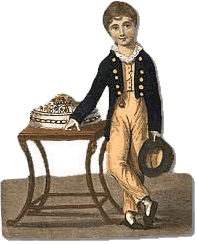 |
The production of paper dolls in Europe began in the
1790s. The dolls were illustrated with their underclothes on and pasted
on cardboard for support. The joints of each were connected by threads
to the body so that the limbs could move into various postures by manipulating
a coordinating thread attached in the back. Dresses and hats accompanied
each doll. The fashion-conscious French enthusiastically welcomed these
new paper dolls from London. A French fashion magazine advertised the
dolls as so appealing that both young girls and grown women would enjoy
them.
S. and J. Fuller
The London toy novelty firm, S. & J. Fuller, produced
a series of books between 1810 and 1816 that came with a paper doll and
various outfits, hand-colored and cut-out. The small books told stories
in verse, centered on a character represented by the paper doll. The character
wore a specific outfit in each episode of the verse; thus, as the book
was read, the doll was supposed to be dressed in the appropriate attire.
The books would often tell morality tales aimed at children. As an example,
in Little Fanny, Fanny is at first an "idle" girl whose
chief activity is playing with her dolls. When her mother refuses to accompany
her to the park, she escapes with her maid and is soon robbed of her clothes.
She appears next as a beggar girl and slowly works her way out of poverty
and into different outfits until she is able to return to her mother.
In the end, Fanny has learned her lesson and appears reading a book instead
of playing with a doll.
The Fuller paper doll design is different than the
original paper dolls of the 1790s. Instead of having an entire body, the
doll consists of only a head and neck. The neck serves as a tab that slides
into slots in the backs of the outfits.
The books were
quite expensive compared to other colored children's books. Selling from
five to eight shillings, they would have been marketed toward the upper
class.
|

|
The History of Little Fanny:
Exemplified in a Series of Figures. London: Printed for S.
and J. Fuller, 1811.
Click on Little Fanny to dress
her in various outfits.
|
|

|
Frank Feignwell's Attempts
to Amuse His Friends on Twelfth-Night: Exhibited in a Series of
Characters. London: Printed for S. and J. Fuller, 1811.
Click on Frank to dress him in
various outfits.
|
|
|

